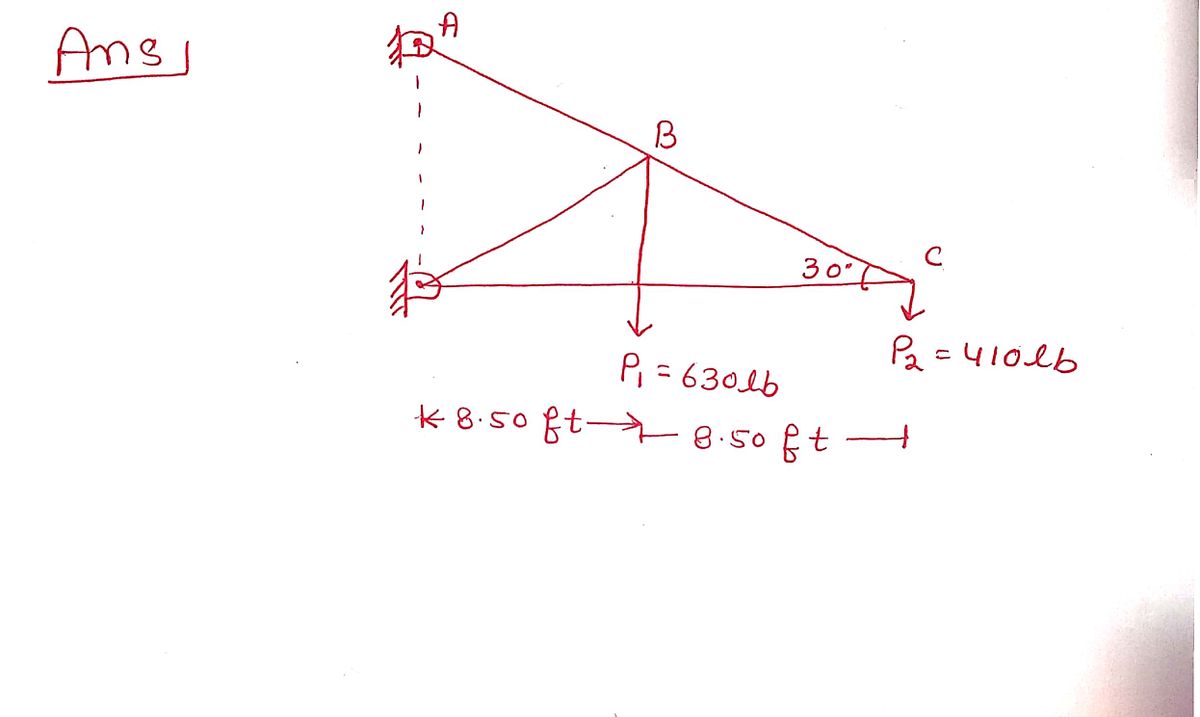Learning Goal: To learn to apply the method of joints to a truss in a systematic way and thereby find the loading in each member of the truss. In analyzing or designing trusses, it is necessary to determine the force in each member of the truss. One way to do this is the method of joints. The method of joints is based on the fact that if the entire truss is in equilibrium, each joint in the truss must also be in equilibrium (i.e., the free-body diagram of each joint must be balanced). Consider the truss shown in the diagram. The applied forces are P₁ = 630 lb and P₂ = 410 lb and the distance is d = 8.50 ft. Figure 1) 1 of 1 E 30° d B D 30° d C
Learning Goal: To learn to apply the method of joints to a truss in a systematic way and thereby find the loading in each member of the truss. In analyzing or designing trusses, it is necessary to determine the force in each member of the truss. One way to do this is the method of joints. The method of joints is based on the fact that if the entire truss is in equilibrium, each joint in the truss must also be in equilibrium (i.e., the free-body diagram of each joint must be balanced). Consider the truss shown in the diagram. The applied forces are P₁ = 630 lb and P₂ = 410 lb and the distance is d = 8.50 ft. Figure 1) 1 of 1 E 30° d B D 30° d C
Elements Of Electromagnetics
7th Edition
ISBN:9780190698614
Author:Sadiku, Matthew N. O.
Publisher:Sadiku, Matthew N. O.
ChapterMA: Math Assessment
Section: Chapter Questions
Problem 1.1MA
Related questions
Question

Transcribed Image Text:Learning Goal:
To learn to apply the method of joints to a truss in a systematic way and thereby find the loading in each member of the truss.
In analyzing or designing trusses, it is necessary to determine the force in each member of the truss. One way to do this is the
method of joints. The method of joints is based on the fact that if the entire truss is in equilibrium, each joint in the truss must also be
in equilibrium (i.e., the free-body diagram of each joint must be balanced).
Consider the truss shown in the diagram. The applied forces are P₁ = 630 lb and P₂ = 410 lb and the distance is d = 8.50 ft.
Figure 1)
1 of 1
A
E
30°
d
B
D
P₁
30°
d
C
Expert Solution
Step 1

Step by step
Solved in 4 steps with 4 images

Knowledge Booster
Learn more about
Need a deep-dive on the concept behind this application? Look no further. Learn more about this topic, mechanical-engineering and related others by exploring similar questions and additional content below.Recommended textbooks for you

Elements Of Electromagnetics
Mechanical Engineering
ISBN:
9780190698614
Author:
Sadiku, Matthew N. O.
Publisher:
Oxford University Press

Mechanics of Materials (10th Edition)
Mechanical Engineering
ISBN:
9780134319650
Author:
Russell C. Hibbeler
Publisher:
PEARSON

Thermodynamics: An Engineering Approach
Mechanical Engineering
ISBN:
9781259822674
Author:
Yunus A. Cengel Dr., Michael A. Boles
Publisher:
McGraw-Hill Education

Elements Of Electromagnetics
Mechanical Engineering
ISBN:
9780190698614
Author:
Sadiku, Matthew N. O.
Publisher:
Oxford University Press

Mechanics of Materials (10th Edition)
Mechanical Engineering
ISBN:
9780134319650
Author:
Russell C. Hibbeler
Publisher:
PEARSON

Thermodynamics: An Engineering Approach
Mechanical Engineering
ISBN:
9781259822674
Author:
Yunus A. Cengel Dr., Michael A. Boles
Publisher:
McGraw-Hill Education

Control Systems Engineering
Mechanical Engineering
ISBN:
9781118170519
Author:
Norman S. Nise
Publisher:
WILEY

Mechanics of Materials (MindTap Course List)
Mechanical Engineering
ISBN:
9781337093347
Author:
Barry J. Goodno, James M. Gere
Publisher:
Cengage Learning

Engineering Mechanics: Statics
Mechanical Engineering
ISBN:
9781118807330
Author:
James L. Meriam, L. G. Kraige, J. N. Bolton
Publisher:
WILEY